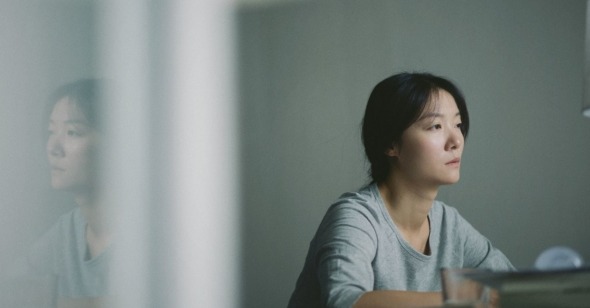Something Happens
By Devika Girish
NYFF:
The Calming
Dir. Song Fang, China, no distributor
Nothing happens in Song Fang’s The Calming in the same way that nothing happens in the films of Chantal Akerman. The scholar Ivone Margulies uses that phrase as the title of her 1996 book on Akerman’s work. “Nothing happens,” she writes, is the definition often applied to films in which “representation's substratum of content seems at variance with the duration accorded it”—where, put more simply, too much time seems to be devoted to something of too little interest. But Margulies elucidates what any discerning viewer of Akerman’s work can grasp: that a non-event is its own kind of thick, textual reality; that even in the starkest, sparest, and stillest shots, the right filmmaker can conjure a viscous sense of happening.
A similar presence-in-absence suffuses The Calming, which documents, with unwavering tranquility, the peregrinations of a young filmmaker, Lin (Qi Xi), through various Asian cities as she screens her latest work and meets family and friends in the wake of a breakup. The film’s austere, contemplative rigor distinguishes it from Song’s first feature, 2013’s Memories Look at Me, a looser-limned autofiction built around the director’s quiet conversations with her parents about family, aging, and mortality. Those themes find their way into The Calming as well: Lin visits her parents (played by Song’s own parents) twice in the film to help her mother attend to her ailing father. But for the most part, The Calming consists of tableaux as elegant and precise as blocks of ice, fixing Lin in the solitude of hotel rooms, cars, trains, and parks, or in moments of hushed chitchat with a curator in Tokyo, a colleague in Beijing, a friend in Hong Kong.
It’s hard to say, beyond sheer description, what happens in these scenes, though one moment in the film offers a kind of key. After attending an exhibition of her work in Tokyo, Lin naps on a train winding through the Japanese snow country. Her small, angular head rests against the window, backlit by the piercing white landscape. The train stops briefly at a station, and then starts again; Lin remains in absolute repose, embodying the distinctive serenity of sleeping on a train—of moving in utter stasis. When she opens her eyes, she’ll be someplace else.
This dialectic of movement through stillness—of the work of rest—is at the heart of The Calming, which captures its heroine in drift between projects, cities, apartments, relationships. The film’s debt to Akerman is unmistakable: its premise echoes Les Rendez-vous d’Anna, another film about the travels and encounters of a young woman filmmaker in the grips of melancholy, and as in works like News from Home and Jeanne Dielman, The Calming is preoccupied with time itself—with its passing; with its radical equalizing of life’s minor and major events. But if in Akerman’s work, as Margulies writes, duration conjures “literalism and figuration… in unstable poise”—producing an affecting tension between sustained banality and moments of dramatic rupture—Song’s film seems to invest entirely in the literal, refusing not just drama but the act of interpretation itself.
Unlike the queer awakening and anticipation that inflects the silences of Les Rendez-vous d’Anna, The Calming gives us no coordinates for Lin’s emotional state. Apart from a brief mention of her breakup at the start of the film, she reveals little about her past or her future. Her conversations with friends and loved ones feel resolutely mundane, even when flecked with intimacy, loss, and death. And Qi, as Lin, remains lucent yet ungraspable. After a screening of her work in Hong Kong, an audience member asks Lin what she’s working on next. “Most likely I’ll be making a series,” she says. “Still in a forest setting, or somewhere else?” the questioner presses further. “I’ll probably be looking at other places,” she says simply. One gets the sense that Lin, in a liminal stage of both life and work, is taking a respite from the frenzy of making meaning, of making sense. The film invites us to do the same.
In place of interpretive footholds, The Calming offers us surfaces and sounds. Lin’s grief is reified in the glint of tears on her face as she lies alone in bed or as she listens, eyes closed, to a live musical performance; her isolation is reflected in the glossy anonymity of the windows she’s frequently framed against. The body’s cycles of regeneration substitute for character arcs in the film. When she visits her parents in Nanjing, Lin joins her mother in gently bathing, feeding, and caring for her father; later, she herself falls ill and recovers, passing through a series of spaces in the process—hotel, cab, hospital, apartment. Eventually, she spends more and more time in nature, with cinematographer Songye Lu holding the camera still as Qi walks lithely through forested paths or gazes silently across a lake. These scenes are rich with ambient sound: the rustle of leaves, the whooshing of winds, the murmur of urban life—all that moves when we are still.
By the time The Calming ends, Lin has moved into a new home, and the camera closes on the sun-dappled, wind-blown trees seen outside the window by her writing desk. The shot recalls the opening image, in which a still from Lin’s latest film, crowded with emerald-green trees, is projected onto the wall of a gallery in Japan. In a surprising bit of narrative closure, the camera lingers on the verdant square of her window, and we hear the scratching sounds of pen on paper, which continue as the credits roll. Lin is writing—as in inscribing—and the gesture recasts her atomized movements throughout the film as a journey to restore creative labor to its primal scenes: of touch, sense, and experience. In the expansive nothingness of the film, something has happened. Lin has awoken from rest, and she is someplace else.
